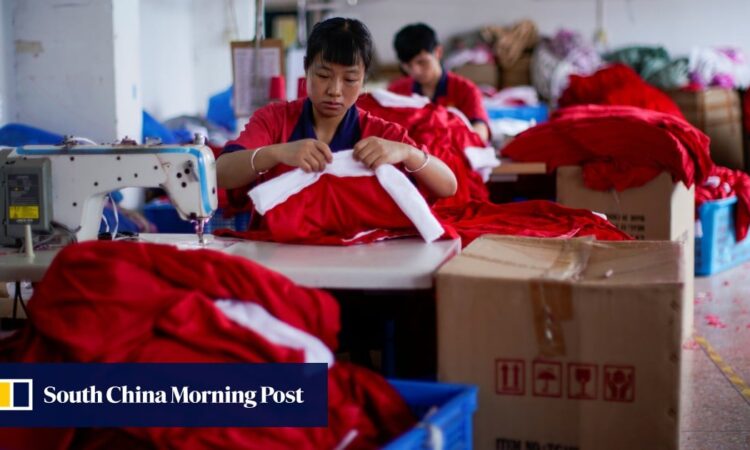
Watts Dean typifies the American holiday consumer, buying goods that are made-in-wherever. And the ubiquity of such indifference in the States during an especially active shopping season is helping China’s exports to the US hold steady despite years of political and trade frictions.
As China looks to shore up economy, geopolitics, US rate cuts weigh on outlook
As China looks to shore up economy, geopolitics, US rate cuts weigh on outlook
Meanwhile, Chinese exporters are so often using third countries, such as Mexico and Vietnam, to ship goods to the US that it can be hard for consumers to know where an item really originated.
“In fact, the trouble with gauging whether American consumers are buying a lot more from places such as Southeast Asia and Mexico is that it’s hard to tell how much of that is, in reality, Chinese goods,” said Christopher Beddor, deputy director for China research at Gavekal Dragonomics. “Any way you slice the data, China is still a major exporter to the US.”
And China’s status is forecast to solidify in 2024.
Goldman Sachs expects 3.1 per cent growth in China’s worldwide exports next year after a 3.4 per cent contraction this year. S&P Global Ratings forecasts an expansion of 4.2 per cent next year from 2 per cent this year on a “turnaround in the tech and electronics cycle”.
They blame the brands, not the suppliers
Orders placed to China for holiday shopping would have reached the US in mid-2023, said Douglas Barry, a Washington-based consultant who follows US-China trade.
Barry also teaches Issues and Image Management in the Communications Department at George Washington University. He recently surveyed his 22 undergraduate students this holiday season and found that the countries of origin had little impact on their holiday shopping choices.
“Some aren’t buying fast fashion any more, not because of the country of origin but because of environmental damage and bad labour practices,” he said. “They blame the brands, not the suppliers.”
Doubts trade can provide China’s economic pillar in 2024 even after exports grow
Doubts trade can provide China’s economic pillar in 2024 even after exports grow
However, Minesh Pore, CEO of the Chinese brand-to-factory sourcing platform BuyHive, said major retailers are finding it tough to “sell” China to the US public. Travel restrictions, he added, have made it harder for brands and suppliers to meet and connect.
According to Pore, Chinese sellers are routing goods through third countries in Latin America and other parts of Asia. And analysts expect those third-country routes to keep US-bound Chinese exports resilient in the years ahead.
Vietnam is another key conduit to the US, and a manufacturing rival of China. The country’s factories primarily export clothing, shoes and consumer electronics.
[I]t’s important to note that China maintains its leading position as the primary source of American imports
China registered 94.9 per cent more direct investment in Vietnam in the first nine months of this year than during the same period of 2022, according to the Southeast Asian country’s Ministry of Planning and Investment.
“It’s remarkable how strong [China] has been despite all the efforts to bring it down,” said Jayant Menon, a senior fellow at the ISEAS-Yusof Ishak Institute in Singapore.
The share of American imports from China has technically dropped from about 22 per cent of the total just before the trade dispute to around 14 per cent today, Beddor said. But “in practice”, he said, the decline has been less steep.
“Despite progress from Mexico, Canada and Vietnam in supplying consumer goods to the US, it’s important to note that China maintains its leading position as the primary source of American imports in this sector,” said Nathan Chow, a senior economist with DBS Bank.
For AliExpress, an online retail service of Chinese e-commerce giant Alibaba, its sales “saw positive growth” on the most recent Black Friday – among the busiest US shopping day each year, taking place immediately after the Thanksgiving holiday when many Americans are off work. A spokesman for the retailer said toys, computer and office supplies, household appliances and furniture were among the top-selling categories. Alibaba owns the South China Morning Post.
Black Friday spending rose nearly 8 per cent, year on year, to about US$10 billion, according to US-based Clarkson Consulting, which attributed the gain to shoppers’ relief over the falling prices of daily expenses such as petrol.
And on November 27 – a day of e-commerce discounts known as Cyber Monday, three days after Black Friday – total spending reached US$12.4 billion, up 9.6 per cent year on year, according to Adobe Analytics.
Analysts say that the stability of the US economy has put Chinese exports on solid footing this year. According to The Conference Board think tank, the US economy should grow 2.4 per cent in 2023, year on year, up from 2.1 per cent in 2022.






